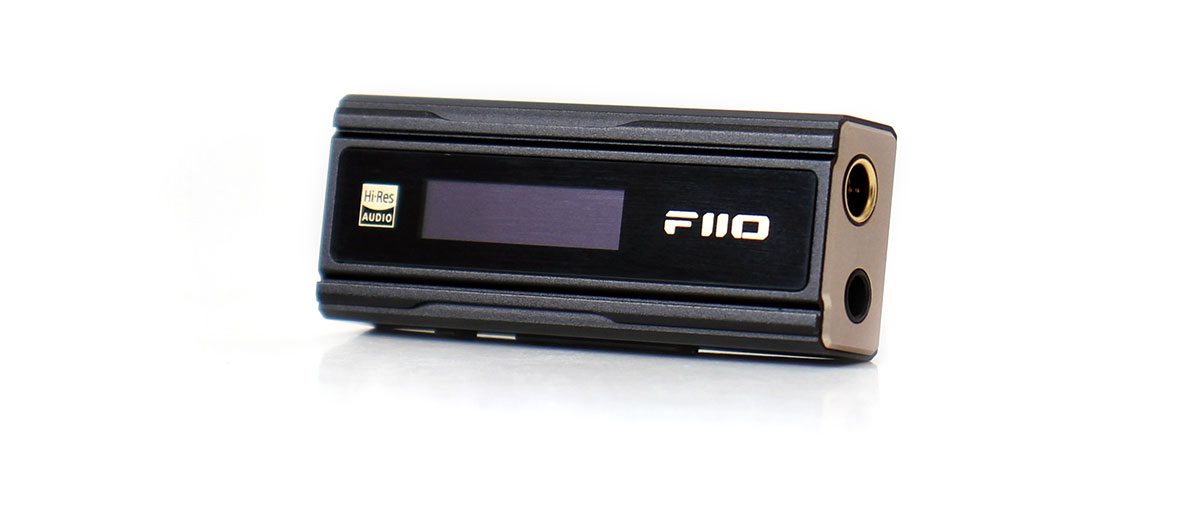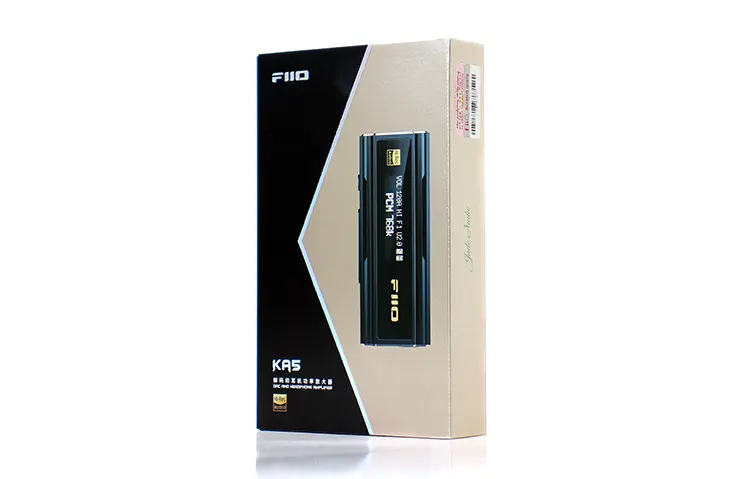Synergy
Power
Dongle DACs were primarily designed to be used in a portable scenario, fed by a mobile device and an IEM connected to one of the output ports. As previously stated, the KA5 can max out any IEM.
However, FiiO mentions that they designed the KA5 to work well with many power-hungry headphones. Power usage from the battery increases according to the headphone’s drivability but it does improve a small amount by going H mode on the DAC section.
My daily cans are HIFIMAN Arya V2 headphones and they’re not easy to drive right. Connected to the KA5, the Arya produced an acceptably loud volume amount at 75% of my phone volume, and the KA5 on max volume with the gain set on high. So, it closely maxed the output capacity.
The bass did remain clean, which was a small feat. However, the KA5 did not take advantage of my Arya’s full imaging capabilities due to its personal-sized stage production and the Arya’s huge staging capabilities.
Pairings
There are no synergy restrictions far as pairing the KA5 with IEMs. I pulled out FiiO’s three top models which are the FD7, FH9, and the FA7s. They all have different characteristics far as driver implementation and represent what’s out there. One is a single dynamic; one a hybrid and one contains an all-BA cluster.
Which one did I like the most? It was the FD7 of course but that particular IEM has my favorite sonic characteristics and the KA5 bought them out fully breaking the stereotypical belief that one should always spend an equal amount on gear and IEM. In this case, there was good synergy at a 1 to 6 cost ratio.
One apparent characteristic that was present in all the FiiO IEM models selected was a neutral character and the fact that the KA5 did not add to the picture but demonstrated each one’s particularities well.
Select Comparisons
xDuoo Link 2 Bal
Technical
The xDuoo Link 2 Bal is the dongle DAC within this comparison that has the most surface buttons of them all. It’s a full-featured dongle DAC but you can’t count on an app to make any adjustments here.
Instead, this dongle onboard has volume controls, a pause button, a USB mode switch plus a normal/turbo button. It also has dual-headphone output connections with a similar 3.5mm and a 4.4mm balanced-out configuration.
The Link 2 Bal relies on two CS4131 DAC chips plus a separate amplifier stage that uses a Texas Instruments LM27762 chip behind a charge pump LDO that claims 80% efficiency. It produces a formidable total of 270mW on the balanced connector.
Far as DAC capabilities, the Link 2 Bal dongle can handle MQA on top of PCM 32bit at up to 384kHz and is the more capable dongle on that front. The kicker is that it offers an extra 5mW on the balanced output on paper although that’s negligible.
Design
The xDuoo Link 2 Bal has a somewhat chunky CNC-shaped aluminum body with curvy corners. Tempered glass covers the front and back with underlays of logos and numbers.
The body has lots of buttons to play with but it could have been done in a better manner. For example, the USB 1.0 mode could have been put at the pause button and activated by a press while connecting method.
They could have done the same with the turbo mode. They could have given us some switchable DAC filters in place of the USB mode switch for example and doubled the available features that way and upfront. The KA5 has these features available, and then some are operable onboard or can also be accessed through the Control app.
Performance
It’s rather interesting the fact that both these dongles take on a neutral but warm character but are done in different ways. Even though both dongles use Cirrus Logic DACs which to me on average sound super flat, these two dongles veer away from that.
For example, the FiiO KA5 has warm vocal tones while the xDuoo Link 2 Bal has that plus a warm-bodied bass section. In the high-frequency department, they present almost identical characteristics and attempt to remain calm and collected, and below annoyance levels.
Shanling UA3
Technical
The Shanling UA3 requires a smaller investment to obtain compared to the KA5. However, it also has the least onboard features and offers a simple collection of buttons on the front to control the volume which also double duty by operating next/previous track selections plus an additional pause/play button.
The neat thing about the UA3 is that you can download and use their app, which is not called an app but a player. It combines the two and once installed, it gives access to many features including a DAC filter selector, a 2-way gain toggle, a low power mode plus access to NAS functions and firmware updates.
The internal DAC section takes a different approach by using an AK4493SEQ with a Delta-Sigma oscillator. It has a higher DSD capability and can reach DSD512 levels of decoding but the PCM mode stays identical at 32bit and at up to 384kHz.
The UA3 also sports dual Ricore RT6863 amps that can push 211mW max power output on the balanced side. And although this dongle has all that hardware it still manages a high level of efficiency far as battery consumption.
Design
The UA3 has the most simplistic appearance of all the dongles in this comparison. It’s an Aluminum alloy constructed chassis with rounded sides and no sharp edges to be found anywhere so it’s pocket friendly.
One thing to note here is that the UA3 does not come with Lightning connectivity and I’m not even sure if it works on an iPhone, for example, so make sure you do some research before you commit if you’re on one of those platforms.
Performance
There’s a funny factoid here within this comparison and this unit. That factoid is that what makes the UA3 stand out is the app.
Performance-wise all these dongles seem to perform similarly far as power output, flatness in frequency response, and the all-important noise level rating. But the app gives you NAS access enabling you to store a massive music collection remotely and gain access to those files from your mobile device.
The UA3 does tend to sound neutral, balanced, and nuanced, But it’s the least forgiving of the dongles in the fact that it doesn’t add any warmth or coloration. So, this might be a great dongle for clarity and Hi-Res, but it might not meet expectations if you use low-res sources.
iBasso DC06
Technical
The iBasso DC06 is the dongle in this comparison that takes the power-punch award since it has the highest power rating of the bunch. It measures 320mW @ 32Ω so it’s a formidable dongle if you’re main concern is having enough power output.
It’s also highly capable in the digital realm since it can play well with MQA files at 16x folding, along with the usual 32-bit 384kHz PCM with a side of DSD256. So that’s the second advantage the DC06 has over the rest, particularly the power output and digital rendering capabilities.
The DAC section uses a dual ES9219C Sabre Quad DAC and a Femtosecond oscillator. What I found odd was that there’s no mention of a power output stage and if there is none, then Shanling must have found a way to squeeze the max potential out of these chips, power output-wise.
iBasso did publish an app that works with the DC06 called UAC but it’s very basic. It does have a 100-step volume plus the app offers firmware updates but it doesn’t offer much else.
Design
The iBasso DC06 gives up all the buttons and apps for all that power and digital rendering capability. The body is an Aluminum chassis but there are no buttons or sliders on it.
The design reminds me of car audio amplifiers that use fin designs to maximize cooling although the DC06 doesn’t need it because it doesn’t run hot.
Connectivity is identical within all these dongle DACs within this comparison and they all use a female USB-C connection for the input side and a dual headphone output config that consists of a 3.5mm SE plus a balanced 4.4mm pentaconn connection.
Performance
The iBasso DC06 seems to be the more powerful dongle compared to the KA5 and it doesn’t raise the noise levels doing so. It’s a good choice if you like high volume levels and plan to use full-sized cans.
There does seem to be a lowball rating power-wise on the KA5 since it seems to portray almost the same amount of grunt but has a much lower number listed on the specification sheet. But the clear winner in that category here is the DC06.
It presents music with a small margin of warmth but remains neutral in general. Tonality remains almost the same between all these dongles except for the UA3 which tends to be flatter in tone and less colored but simultaneously less forgiving of the source.
Each dongle device here has small margins of sound differences so just look for compatibility and particular features. For example, the more powerful is the DC06 followed by the FiiO KA5.
Perhaps the NAS access of the UA3 appeals to you. The KA5 doesn’t have that but it counterbalances with an ample amount of features and similar performance.
Our Verdict
FiiO stuffed the KA5 with lots of good stuff like dual flagship DACs and dual amplifier chips, gave it an OLED screen with lots of accessible, useful features, and put a modest price tag on it. What’s not to like?
Perhaps you could nitpick at the slight sharpness of the end caps but that’s certainly not a dealbreaker. Because there’s nothing else to complain about here.
FiiO and Jade Audio executed this launch well and gave credence to the phrase “practice makes perfect” because it’s FiiO’s latest best dongle DAC to date. I can’t wait to see what the team will come up with next.
FiiO KA5 Technical Specifications
- DAC: 2x CS43198
- Supported formats: PCM 384kHz/32 bit, DSD256
- USB connector: Type C USB 2.0/1.0
- Dimensions: 56.3 x 22 x 12 mm
- Weight: About 19g
- Display: OLED screen
- Output power: SE 122mW + 122mW @ 32Ω / THD-N 1%
- Output power: Balanced 265mW + 265mW @32Ω / THD-N 1%
- SNR: 124dB SE / 128dB @32Ω A weighted
- Noise floor: PO SE 6µV / BAL 1.8µV A weighted
- Output impedance: SE 0.3Ω / BAL 0.35Ω
- THD-N: SE 0.00037% / BAL 0.00037% @ 1kHz 32Ω
- Color: black or white







